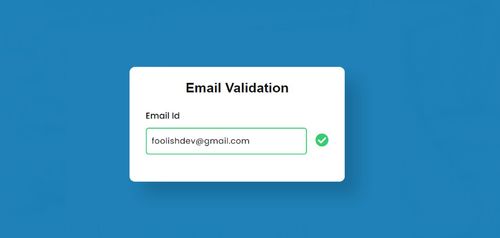Emails are the lifeblood of digital communication. From user registrations to sending critical updates, emails are a fundamental part of modern applications. However, to harness the power of emails effectively, you need to ensure that the email addresses you collect are valid and accurate. In this comprehensive guide, we'll delve into the world of simple email validation, teaching you the essential techniques and providing JavaScript code snippets to master this art.
The Importance of Email Validation
Email validation is not just a nice-to-have feature; it's a critical aspect of data integrity, user experience, and security. Here's why simple email validation is so vital:
1. Data Integrity
- Valid emails ensure that your user database remains accurate and free from fake or erroneous entries.
2. User Experience
- A smooth and reliable email validation process enhances the user experience, reducing frustration during registration.
3. Security
- Validating emails helps prevent spam accounts, phishing attempts, and other malicious activities, making your application more secure.
4. Regulatory Compliance
- Some regulations, such as GDPR, require accurate user data handling. Email validation contributes to compliance with such laws.
Simple Email Validation Techniques
Let's explore some simple yet effective techniques for email validation, along with JavaScript code snippets to implement them.
Technique 1: Regular Expressions
JavaScript Code Snippet:
function validateEmail(email) {
const regex = /^[^\s@]+@[^\s@]+\.[^\s@]+$/;
return regex.test(email);
}
Explanation:
- Regular expressions are powerful tools for email validation.
- The regex pattern
/^[^\s@]+@[^\s@]+\.[^\s@]+$/checks for basic email format correctness. - It ensures there's an "@" symbol, at least one character before and after it, and a period followed by at least one character after "@".
Technique 2: HTML5 Input Type
HTML Code Snippet:
<input type="email" id="emailInput" name="email">
<button onclick="validate()">Validate Email</button>
JavaScript Code Snippet:
function validate() {
const emailInput = document.getElementById("emailInput");
if (emailInput.checkValidity()) {
alert("Email is valid!");
} else {
alert("Invalid email. Please enter a valid email address.");
}
}
Explanation:
- HTML5 introduces the
type="email"attribute for input fields, providing built-in email validation. - JavaScript's
checkValidity()method checks if the input value is a valid email.
Technique 3: Simple JavaScript Validation
JavaScript Code Snippet:
function validateEmail(email) {
const atIndex = email.indexOf('@');
const dotIndex = email.lastIndexOf('.');
if (atIndex < 1 || dotIndex - atIndex < 2) {
return false;
}
return true;
}
Explanation:
- This approach checks for the presence of "@" and "." characters at appropriate positions.
- It's a straightforward method for basic email validation.
Common Questions About Simple Email Validation
Q1: What's the simplest way to validate an email address?
The simplest way is to use HTML5's <input type="email"> attribute. It provides basic email format validation without requiring any JavaScript code.
Q2: Are regular expressions the best choice for email validation?
Regular expressions are a powerful and flexible choice for email validation, but they can be complex. Depending on your requirements, using HTML5 input types or simple JavaScript checks may suffice.
Q3: Can email validation prevent all spam accounts?
While email validation is an essential step in preventing spam accounts, it's not foolproof. Additional measures like CAPTCHA or email confirmation links can enhance spam prevention.
Q4: Are there third-party libraries for email validation?
Yes, there are libraries like "validator.js" and "email-validator" that provide comprehensive email validation functions, making it easier to implement in your projects.
Conclusion
Simple email validation is a fundamental practice that ensures the accuracy and reliability of email addresses collected in your applications. Whether you choose regular expressions, HTML5 input types, or simple JavaScript checks, incorporating email validation into your user registration and communication processes is a step toward data integrity, user



